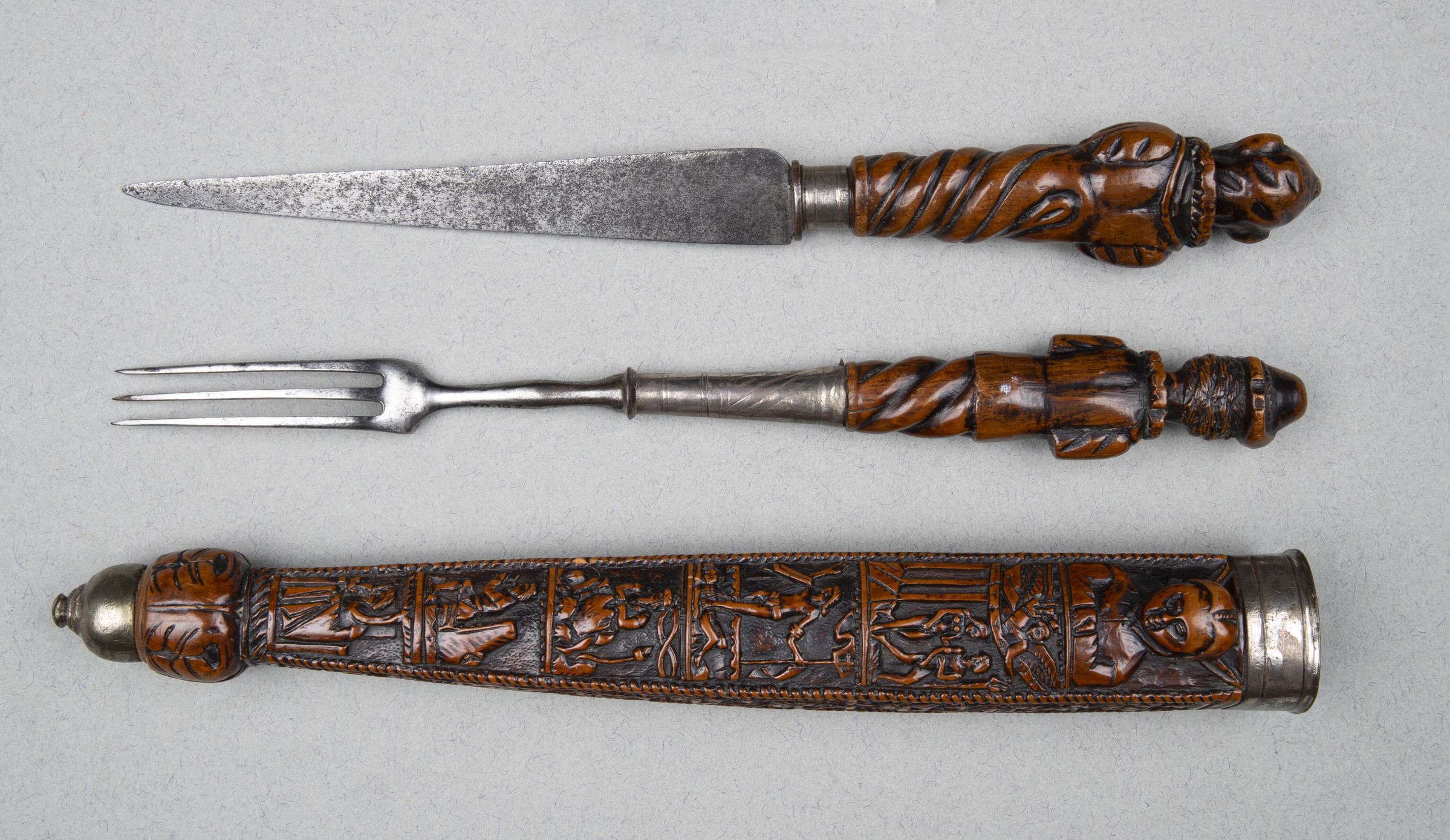Name/Title
Knife and fork in sheathEntry/Object ID
0000.1.261Description
261.01 Knife: Blade sharply tapering and single edged.
261.02 Fork: Head of steel with three curved tines and long baluster neck. Handles: Boxwood, tapering and approximately circular in section, with the upper halves carved as half-length armless male busts, and the lower halves spirally fluted.
On the knife handle, the man is perhaps intended to represent a Jester; he wears a woman's dress, with puffed, leaf-shaped upper sleeves and a small ruff; on his head, is a close-fitting, combed hood with prominent ears, and round his neck is a triple chain (?) with an oval pendant; he wears a close-cut, blunt-pointed beard and moustache. The spiral fluting on the lower part of the handle, contains a tendril of foliage terminating, at the front, in a multi-pointed leaf, and, at the back, in an oval leaf slit centrally. The plain tapering lower section is here only 10 mm long, and is reinforced with a silver (?) ferrule engraved with two encircling lines; set between this and the blade, is a small steel disc pierced for the tang.
On the fork handle, the man wears a custume in the style of the late 16th century, comprising:- a doublet or jerkin, buttoned up the front and with slashed upper sleeves (the lower parts are not represented); a small ruff; hat (copintank) with crown of truncated conical form, twisted band, and a narrow brim with a turned-up flat on the right, held by a tab buttoned to the crown. He wears a close-cut, pointed beard and moustache, and his hair is dressed round the back of his head. Below the spiral fluting, the handle continues as a plain tapered section covered with a thin sheet of silver (bent round and soldered together) for a further 40mm to join the neck of the fork; the silver is roughly engraved with horizontal bands partly filled with spiral hatching.
261.03 Sheath: Carved from a single piece of boxwood, with separate compartments for the knife and fork; it is leaf-shaped, of rectangular section, with the two wider faces slightly convex; it terminates at the bottom in a ball-like feature, carved with foliage, above a cup-shaped silver (?) chape (secured in place with pitch) terminating in a stepped button; the mouth-locket of silver (?) is formed as a simple cap, its top pierced for the two compartments, and its sides encircled by two engraved lines; at the top of the back, is a boss (forming the head of the Jester described below) with a transverse hole for a suspension cord.
The whole surface of the sheath case is carved in relief, mainly with an iconographic scheme illustrating the Old and New Testaments, framed along the main edges, and across the top and bottom, in cabled mouldings. The arrangement is as follows:-
Back: Six rectangular panels, of which the top one contains a head-and-shoulders full-face bust of a Jester, his hands clasped in front of him; he is clean-shaven, and wears on his slightly bowed head, a close-fitting hood with comb and ass's ears; his head is in much higher relief than the other carving, and forms the boss which is pierced for a suspension cord mentioned above.
The other panels contain the following scenes, commencing at the top:-
A. The expulsion of Adam and Eve from the Garden of Eden
B. The Resurrection.
C. Samson holding open the lion's mouth.
D. Jonah emerging from the whale's mouth.
E. Jesse seated asleep on a chair; a shoot emerges from his chest, dividing into two branches which go off respectively to the left and right.
Sides: The branches mentioned above in E continue up each side as the two halves of the normal Tree of Jesse, bearing full-length figures of Kings.
Front: The two branches of the Tree of Jesse merge at the top of the front in the half-figures of the Virgin and Child, flanked by two half-length Kings. Both have five panels, as on the back, containing the following scenes, commencing at the top:-
F. The Creation of Eve.
G. The Adoration.
H. The Temptation
I. The Crucifixion.
J. A shield, incised with the owner's (?) mark, like a complex figure 4, held by an Angel; carved at the bottom, are, on one side, the maker's (?) initials WGW, and, on the other, the date 1577.Collection
Cutlery Collection, Fork and KnifeMade/Created
Date made
1577Time Period
19Place
Country
Germany or HollandContinent
EuropeInscription/Signature/Marks
Notes
On blade : 'AMANJE' dated 1577Other Names and Numbers
Other Numbers
Number Type
Cutlery Collection Record BookOther Number
CC261Dimensions
Dimension Notes
Length: Knife: 227mm
Fork: 227mm
Sheath: 233mm
